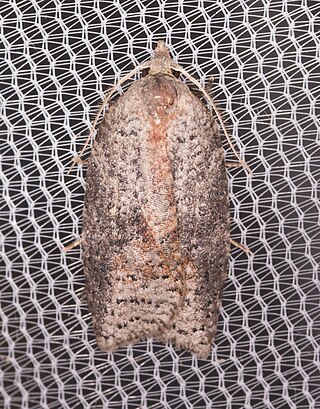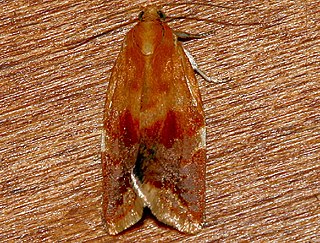
Ptycholoma lecheana, the Leche's twist moth, is a moth of the family Tortricidae. It is found in Europe, China, Korea, Japan, Russia and Asia Minor.

Zeiraphera isertana is a moth of the family Tortricidae. It is found in China, Russia, Europe and the Near East.

Zeiraphera improbana, the larch needleworm moth, is a moth of the family Tortricidae. It is found in North America.

Zeiraphera is a genus of moths belonging to the subfamily Olethreutinae of the family Tortricidae.

Ditula angustiorana, the red-barred tortrix, is a moth of the family Tortricidae found in Africa, Asia, Europe and North Africa. Other common names are the fruit-tree tortrix and the vine tortrix. The moth was first described by Adrian Hardy Haworth in 1811.

Zeiraphera ratzeburgiana, the spruce bud moth or Ratzeburg tortricid, is a moth of the family Tortricidae. It is found from northern and central Europe to eastern Russia and China. Zeiraphera ratzeburgiana is a taxonomically similar species to Zeiraphera canadensis and can only be distinguished by an anal comb found in Z. canadensis.
Zeiraphera rufimitrana, the red-headed fir tortricid, is a moth of the family Tortricidae. It is found from central Europe to eastern Russia, Mongolia, the Korean Peninsula, China and Japan. It was first recorded from the Netherlands by Kuchlein and Naves in 1999.

Clepsis senecionana, the rustic tortrix, is a moth of the family Tortricidae. It is found from Europe to eastern Siberia.

Ctenopseustis obliquana, the brownheaded leafroller, is a moth of the family Tortricidae. It is native to New Zealand and is an introduced species in Hawaii. The common name is also used for the related species Ctenopseustis herana and Ctenopseustis fraterna.

Pandemis corylana, the chequered fruit-tree tortrix, hazel tortrix moth, filbert tortricid or barred fruit tree moth, is a moth of the family Tortricidae. It is found from northern and central Europe to Siberia, Korea and Japan.

Amorbia humerosana, the white-lined leafroller, is a species of moth of the family Tortricidae. It is found from the Gulf states to the northeastern United States and southeastern Canada.
Argyrotaenia occultana, the fall spruce needle moth, is a moth of the family Tortricidae. The species was first described by Thomas Nesbitt Freeman in 1942. It is found in North America, where it has been recorded from British Columbia north to Yukon and Northwest Territories, east to Newfoundland and south to Kentucky and Oregon. The habitat consists of spruce forests.

Clepsis persicana, the white triangle tortrix or the green needleworm, is a species of moth of the family Tortricidae. It is found in North America, where it has been recorded from Alaska and British Columbia to Newfoundland and south to Virginia and west to California. The habitat consists of coniferous and mixed coniferous forests.

Homonopsis foederatana is a species of moth of the family Tortricidae. It is found in Korea, Japan and the Russian Far East (Ussuri).

Homonopsis illotana is a species of moth of the family Tortricidae. It is found in China, Korea, Japan and the Russian Far East.
Spilonota albicana, the white fruit moth, larger apple fruit moth or eye-spotted bud moth, is a species of moth of the family Tortricidae. It is found in China, Korea, Japan and Russia. It has been accidentally introduced in the Netherlands.
Zeiraphera gansuensis is a species of moth of the family Tortricidae. It is found in China.
Zeiraphera lariciana is a species of moth of the family Tortricidae. It is found in China and Japan.

Zeiraphera subcorticana is a species of moth of the family Tortricidae. It is found in China, Japan and Russia.
Zeiraphera diniana, also known by its common name in Japan, the douglas fir cone moth, is a species of moth belonging to the family Tortricidae. The species is considered to be invasive, and is considered a pest of Larix decidua, as caterpillars defoliate the trees.













